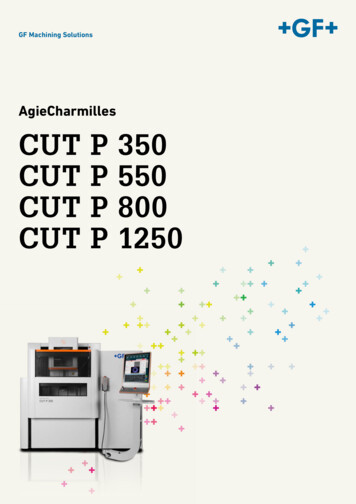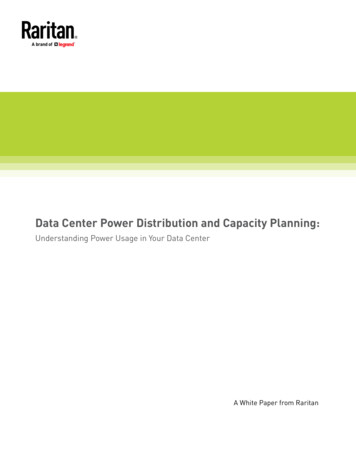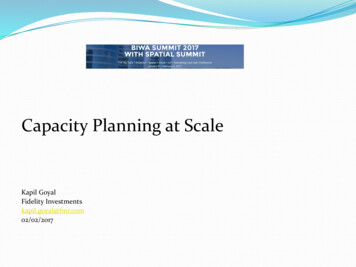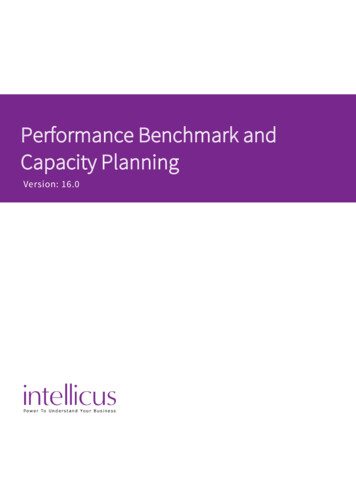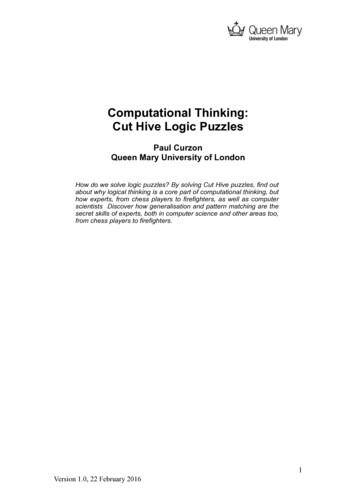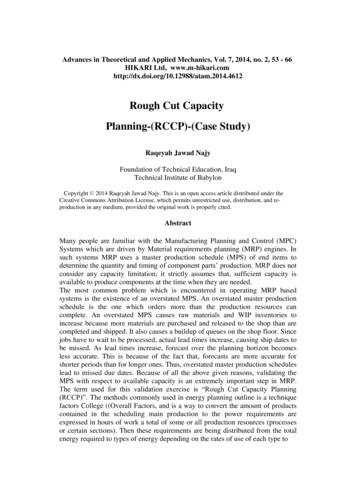
Transcription
Advances in Theoretical and Applied Mechanics, Vol. 7, 2014, no. 2, 53 - 66HIKARI Ltd, 14.4612Rough Cut CapacityPlanning-(RCCP)-(Case Study)Raqeyah Jawad NajyFoundation of Technical Education, IraqTechnical Institute of BabylonCopyright 2014 Raqeyah Jawad Najy. This is an open access article distributed under theCreative Commons Attribution License, which permits unrestricted use, distribution, and reproduction in any medium, provided the original work is properly cited.AbstractMany people are familiar with the Manufacturing Planning and Control (MPC)Systems which are driven by Material requirements planning (MRP) engines. Insuch systems MRP uses a master production schedule (MPS) of end items todetermine the quantity and timing of component parts’ production. MRP does notconsider any capacity limitation; it strictly assumes that, sufficient capacity isavailable to produce components at the time when they are needed.The most common problem which is encountered in operating MRP basedsystems is the existence of an overstated MPS. An overstated master productionschedule is the one which orders more than the production resources cancomplete. An overstated MPS causes raw materials and WIP inventories toincrease because more materials are purchased and released to the shop than arecompleted and shipped. It also causes a buildup of queues on the shop floor. Sincejobs have to wait to be processed, actual lead times increase, causing ship dates tobe missed. As lead times increase, forecast over the planning horizon becomesless accurate. This is because of the fact that, forecasts are more accurate forshorter periods than for longer ones. Thus, overstated master production scheduleslead to missed due dates. Because of all the above given reasons, validating theMPS with respect to available capacity is an extremely important step in MRP.The term used for this validation exercise is “Rough Cut Capacity Planning(RCCP)”. The methods commonly used in energy planning outline is a techniquefactors College ((Overall Factors, and is a way to convert the amount of productscontained in the scheduling main production to the power requirements areexpressed in hours of work a total of some or all production resources (processesor certain sections). Then these requirements are being distributed from the totalenergy required to types of energy depending on the rates of use of each type to
54Raqeyah Jawad Najythe total species during the last period, which has been used in this paper as a casestudy in the medical syringe plant in Babylon in Iraq.IntroductionThe essence of energy planning productivity detailed (RCCP-Rough Cut CapacityPlanning is the conversion of production scheduling Home (MPS-Masterproduction Schedule) to the energy needs of core resources, and then determinewhether scheduling the main possible within the determinants of productioncapacity. If you were not as well as it should change Schedule Home and modifiedin order to be within the constraints of energy. and in some cases may be requiredto change the total in order to be within the limits of power. Accordingly, theprocess of energy planning outline is closely linked with the productionscheduling Home.-Research Methodology: - includeA - Research problem: lie in the following points: 1 - Do not interview the maturity date.2 - not kept at the lowest level of the reserved capital in production.3 - Increasing industrial deadlines.4 - Increase the time third party product.5 - Lack of modern management information than is required to do in the field ofenergy productivity.B - the objectives of the research: - The thus: 1 - Planning the required levels of energy productivity in all centers of productionand determine the number of machines and labor force required for access to themain production scheduling (MPS).2 - to give accurate estimates of the detailed energy for the plant and all products.C - The importance of research:The importance of research need to be productive capacity available is sufficientand able to enable the factory to satisfy current demand and future right time andthe right amount and in a manner consistent with the message factory. It is alsonecessary owning institution capacity appropriate so that ICON has a surplus ofthis energy and thus become production costsHigh, which will affect the competitiveness of the plant. Must also make it clearthat there is a shortage because it will reduce the ability of factory to satisfy thedemand of time and the right amount and without recourse to some of the policiesmandated policy overtime or rely on other suppliers or request waiting customers.
Rough cut capacity planning-(RCCP)-(case study)55D - Search Tools: Will be the adoption of a methodology (case study) and the reality of the detailedwork to production lines in the medical syringe plant in Babylon.-Theoretical side:-First: The concept of capacity and energy requirements planning (RCCP)For energy production known (Evans,2005) as a measure of the amount ofproduction that can be produced during the period of time a source is importantand that you should be able institution of control. Expressed as the maximumamount of units produced during a certain time-period. With regard to energyrequirements planning (RCCP) them (Slack, 2004) as the maximum level ofactivity of the value-added (Added-Value) for a certain period of time and whichmanaged to get the job done under normal operating conditions.Known as the process of balance between the industrial unit available resourcesand the burden arising as a result of the demand for those products unit. The(Evans, 2005) confirms that the process of planning the energy needs are similarto those in the energy planning model and the difference is that the MRP systemcreates the required quantities of full and timing of each part and component whilethe MPS poses simply article concluding programmed addition examines energyplanning and basic equipment for private and action Center (jams) and examinesthe planning for the energy needs of several business centers and thus providesmore details and information, and that the energy needs of these sums after thatlength of time and action Center, for the purpose of presentation of the accounts(RCCP).As for the concept of production scheduling Home (MPS): requires thedirection and guidance of operations in the factory to the detailed plans shortterm, and since the plan's total production is characterized by generalized, it isfragmented to schedule a major production. Means scheduling main producing asdetailed schedule (is usually on a weekly basis or even daily) quantity that nonproduction of certain products or groups of products.And known (Evans, 2005) as the final amount of detection finished products to beproduced and when it will be produced?The ((MPS production plan the production of short-term takes into account boththe overall demand on the resources of the factory and energy and processors areusually put this plan on a weekly basis for a period ranging between (6-12) weeksand derives most of its plans for materials, labor and equipment from this plan.The purpose of the (MPS) is to translate the plan total to a detailed plan for theproducts individually as they provide essential inputs to the planning systemphysical requirements (MRP). Moreover, they help managers to develop priorities
56Raqeyah Jawad Najyfor scheduling by selecting the maturities of production Products individual.The formulation can be (MPS).There is no general agreement on the level of detail that should be incorporated inthe MPS validation. An APICS monograph presents case histories of severalcompanies, including details on the capacity planning process. Some companiesusing very crude techniques while others are using detailed, time phased,methods.Basically there are three approaches to perform rough cut capacity planning.These can be summarized as follows;a)Capacity planning using overall factors (CPOF) :It is the least detailed approach. Capacity requirement is quickly computed but isinsensitive to shifts in product mix.b)“Bill of labor” (or bill of required types of machine hours) approach :It involves multiplying two matrices, “the bill of labor” and the “masterproduction schedule”. This approach picks up shifts in product mix, but does notconsider lead time offsets. It strictly assumes a lot-for-lot policy for setting lotsizes. When other techniques, such as economic order quantity etc is used, thenthis approach gives a very rough estimate.c)“Resource Profile” approach :It is exactly same as “Bill of labor approach”, except that it takes lead-timeoffsets into account. Again, it strictly assumes a lot-for-lot policy for setting lotsizes as in the case of “bill of labor approach”.For the above indicated reasons, “the bill of labor” approach is recommendedbecause it is easily implemented on a personal computer and is just as accurate asthe more cumbersome “resource profile approach”.In any event, rough cut capacity planning should be used only to determine ifsufficient capacity exists over broad time frames such as a month or aquarter.-The role of capacity planning in the production planning and controlsystem.An overview of the entire manufacturing planning and control (MPC) processbased on MRP is given in Figure 2. Within this process, capacity managementtechniques are usually separated into four categories as;a)b)c)resource requirements planning (RRP),rough cut capacity planning (RCCP),capacity requirements planning (CRP), and
Rough cut capacity planning-(RCCP)-(case study)57d)input/ output controlIn fact, these capacity management techniques represent the four planning timehorizons considered. In a typical MRP system the general sequence is; to create amaster schedule, use rough cut capacity planning to verify that the MPS isfeasible, perform the MRP explosion, and send planned order release data tocapacity requirements planning.Figure 1: An Overview of Capacity ManagementIt is appropriate ways with energy demand: 1 - to make changes in functional staffs.2 - Amendment of equipment and processes which includes the purchase of newmachines.3 - Improved methods (approaches) to increase production.4 - Redesign the product to facilitate more output.It must be taken into consideration when planning capacity term:** Benefit from the use of: - UtilizationRate indicates beneficial to add additional power or cancel the required energy isthe greatest difficulty lies in the calculation of the benefit in determining themaximum energy, as follows:
58Raqeyah Jawad Najy- Utility (Utilization Effective ((output / capacity-efficient) X 100%Input rate: LoadWIP InventoryOutput rate: CapacityFigure 2: Load andCapacityPriority and capacity are balanced by various techniques. For PP, MPS andMRP, theCorresponding capacity planning tools are resource requirement planning (RRP),rough-cut capacity planning (RCCP), and capacity requirement planning (CRP).Figure 3 shows the relations of the priority and capacity plans.PPRRP6MP SRCCPMR PCRPFigure 3: Relations of Priority and Capacity plansThe Practical Side:Assuming a practical example of the planned orders demand for the componentare as follows: -
Rough cut capacity planning-(RCCP)-(case ming that requires component (1.10) hours of work per unit in a particularduty station and (1.5) hours of the time of configuration and setup, authorized:energy needs in the period (1) is(20 units)*(1.10) (1.5h) 23.5 hrThe same is true in the periods (3.4), as we have(25 units)*(1.10) (1.5 h) 29 hrSuch information is usually available in the report of pregnancy (Load Report).Van there were not enough power available must make decisions about overtime,transportation of personnel between departments, hiring secondary education, theprogram is the basis for the production may have to modify also the face of theavailable power, and that this requires recycling program (MRP), to provideplanning for energy needs feedback between basic programming and (MRP).And reflects (Waller, 2003) for (RCCP) that production program basic developerof customer's requests fixed or expected, forecasts, reports the position ofproduction and information capacity, requests urgent very placed in the first placeand available for (MPS) and including that all requests have been made in spaceensuing detailed and energy planning which shows the pregnancy center workwith regard to energy production available energy has the equivalent of pregnancyis likely to exceed the load energyHe adds (Schroeder, 2000) an important point with regard to the detailed planningof energy that should be used the closed session of the system (MRP)Explain (Evans, 2005) as a case study model factories couldn beer (Golden Brew)It did not specify whether the energy is sufficient and available and under a shorttime to be able to achieve (MPS), and under the working conditions of ordinaryLaffan power plant (2200) barrels per month (or 5.867) fund in the week, andovertime can increase the power to the ((2800 barrels per month (or (7.467 Fundin the week, these selections are due capabilities Equipment Co., Ltd. production.,and (Tab key) found that for week (12) has been production within energy, andbeyond this point, the program planned for golden cannot be achieved within thelimits of (7.467) per week Fund, Therefore Snmay the saying that the basicprogram is inadequate.
60Raqeyah Jawad NajyThis is the essence of energy detailed any conversion (MPS) to the needs ofenergy sources basic selection after that whether the basic program appropriate.With regard to the limits of power, the program is essential that modifies (MPS)to remain within the parameters (restrictions) energy, and in some cases It may benecessary to modify the plan total production, for example, in the weeks (14 and15) will be produced ((Golden Delight and early in the week (15) are switching to(Golden Brew) is produced by the latter for week (18) when they are switching to(Golden Delight) and so on. permission: detailed energy planning processduplicate associated with basic programming for production.Key advantage in energy planning detailed is the public scrutiny quick andinexpensive for the availability of the main needs of energy for theimplementation of scheduling the main production. Provide such a feature whichmay acceptance of the results approximate that gives it that the level of precisionavailable where enough to make decisions about the validity of scheduling Homefor implementation. among methods commonly used in energy planning outline isa technique factors College ((Overall Factors, and is a way to convert the amountof products contained in the scheduling main production to the powerrequirements are expressed in hours of work a total of some or all productionresources (processes or specific sections) . then those requirements are beingdistributed from the total energy required to types of energy depending on therates of use of each type to the total species during the last period, which havebeen used in this paper as a case study and also in the medical syringe plant inBabylon according to Dilwoorth method. As shown in the tables below:A large syringeB medium syringeC small syringeThe following is a tentative master schedule for 12 weeks at a syringe plant inBabylon:Table (1) Master scheduling for products A, B, CproductDuration123456789101112A1500 1800 20001500 2100 1800 1500 2000 1500 1500 1500 2000B2000 3000 25002000 2000 2000 2800 2000 2000 2800 2000 3000C2300 2300 23002500 2500 2500 2300 2800 4000 3800 3500 4000
Rough cut capacity planning-(RCCP)-(case study)61Table (2) the bill of labor in the key work centers for the plant three majorproducts is as 0.1020.060.100.1230.110.080.15CDetermine the load on department (1) over the next 12 weeks. The load profile fordepartment (1)over the next 12 weeks is found by multiplying the laborrequirement in department(1)for each product by the quantity of that product to beproduced in each week and summing the hours required for all products in eachweek.Hours required in each weekWeek 1For product A 0.20(1500) 300For product B 0.06(2000) 120For product C 0.10(2300) 230Sum 650Week 2A 0.20(1800) 360B0.06(3000) 180C0.10(2300) 230Sum 770
62Raqeyah Jawad NajyWeek3A0.20(2000) 400B0.06(2500) 150C0.10(2300) 230Sum 780Week4A0.20(1500) 300B0.06(2000) 120C0.10(2500) 250Sum 670So on of weeks rest.(from 5-12)to department(1).Determine the load on department (2) over the next 12 weeks. The load profile fordepartment (2)over the next 12 weeks is found by multiplying the laborrequirement in department(2)for each product by the quantity of that product to beproduced in each week and summing the hours required for all products in eachweek.Hours required in each weekWeek1A 0.06(1500) 90B0.10(2000) 200C0.12(2300) 276Sum 566Week2A 0.06(1800) 108B0.10(3000) 300C0.12(2300) 276
Rough cut capacity planning-(RCCP)-(case study)63Sum 684Week3A0.06(2000) 120B 0.10(2500) 250C0.12(2300) 276Sum 646Week4A0.06(1500) 90B0.10(2000) 200C0.12(2500) 300Sum 590So on of weeks rest. (From 5-12) to department (2).Determine the load on department (3) over the next 12 weeks. The load profile fordepartment (3) over the next 12 weeks is found by multiplying the laborrequirement in department(3)for each product by the quantity of that product to beproduced in each week and summing the hours required for all products in eachweek.Hours required in each weekWeek1A 0.11(1500) 165B0.08(2000) 160C0.15(2300) 345Sum 670Week2A0.11(1800) 198B0.08(3000) 240
64Raqeyah Jawad NajyC0.15(2300) 345Sum 783Week3A0.11(2000) 220B0.08(2500) 200C0.15(2300) 345Sum 765Week4A0.11(1500) 165B0.08(2000) 160C0.15(2500) 375Sum 700So on of weeks rest. (From 5-12) to department (3).Table (3) Rough cut capacity planning for plant to Month 1 in all Week3740600851Week4555480925Sum of Month 1251622803478So on for all months in year are the same determined.
Rough cut capacity planning-(RCCP)-(case study)65-Conclusions:1-Insight: distinction between independent and dependent demands2-Advantages: General approach Supports planning hierarchy (Mps)3-Problems: Assumptions ---especially infinite capacity Cultural factors --e.g., data accuracy, training, etc.4-Multiple demand types and planning passes helped to plan seasonal peakswithin the constraints of time and capacity while honoring everyday requirements5-The CTM planning engine was chosen to layer supply source decisions in onerun while considering priorities, capacity, modes, and quotas6-RCCP decisions integrate with the detailed planning through the use of twotables6-1 Key Dates table to move forecast to a common date and to fix orders.6-2 Internal/External Allocation table to guide DRP sourcing choices.7-The simple rough cut network of locations and resources were used to modelchoices, not physical assets.References[1] Arnold, J.R. Tony, Stephen N. Chapman and Lloyd M. Clive, Introduction toMaterials Management, Sixth Edition. Upper Saddle River, N.J.: PearsonEducation Limited, 2008.[2] Blackstone, John H. Jr., Capacity Management. Cincinnati, Ohio: SouthWestern, 1989.[3] Cox, James F., III, John H. Blackstone, and Michael S. Spencer, eds. APICSDictionary, Falls Church, Va.:American Production and Inventory ControlSociety, Inc., 2005.[4] Dilwoorth, James, B., Operations Management, Design Planning and Controlfor Manufacturing and Service, New York, McGraw-Hill, Inc, 2000.[5] Evans, James R., Production/Operations Maagement: Quality, Performance,and Value.5th ed, USA, West Publishing Company, 2012.[6] Gessner, Robert A., Master Production Schedule Planning. NewYork: JohnWiley & Sons, 1986.[7] Jonsson, P., Mattsson, S.-A. "The Implication of Planning Environments onthe
Jan 04, 2014 · master schedule, use rough cut capacity planning to verify that the MPS is feasible, perform the MRP explosion, and send planned order release data to capacity requirements planning. Figure 1: An Overview of Capacity Management It is appropriate ways with e
